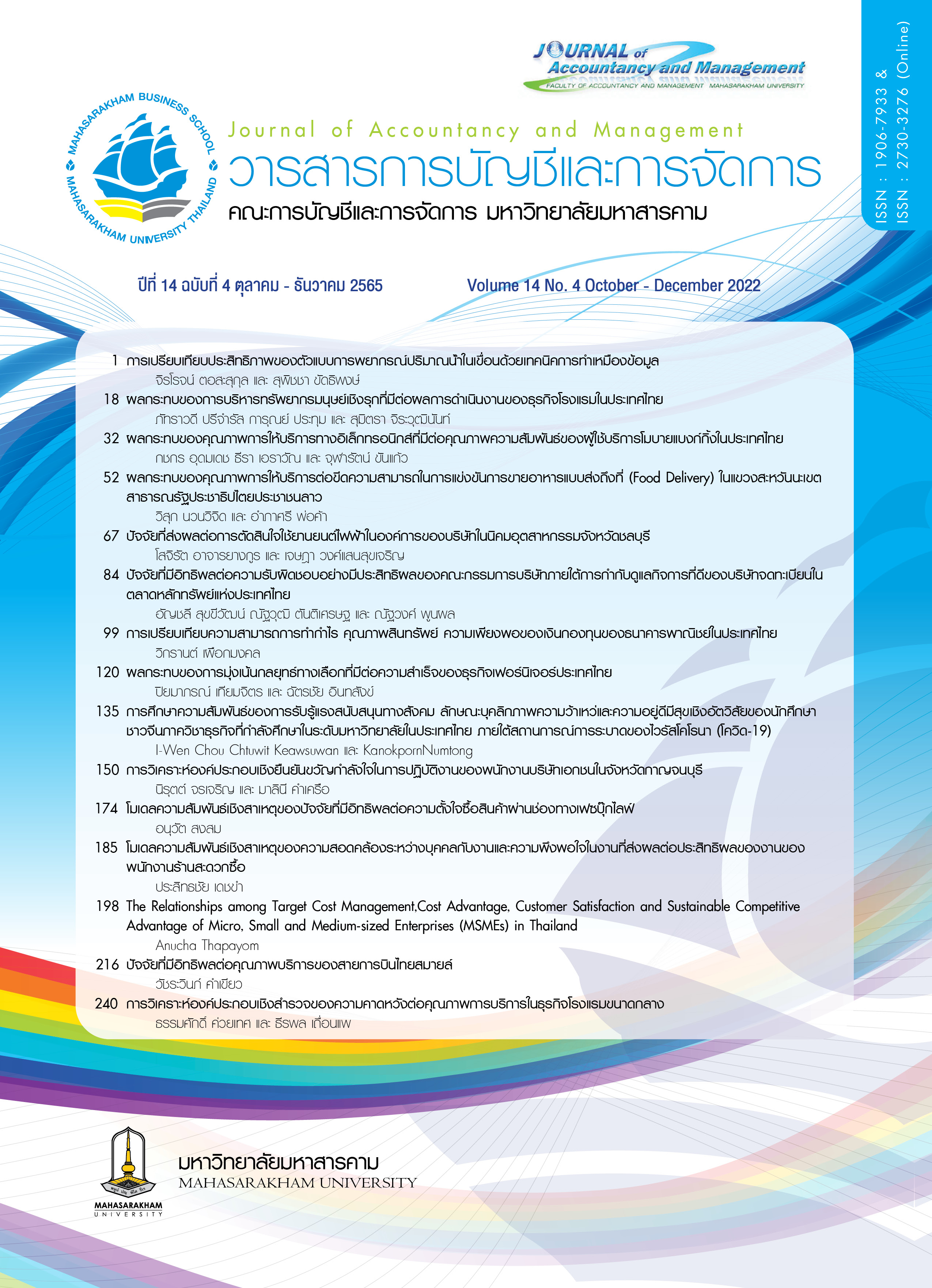การเปรียบเทียบประสิทธิภาพของตัวแบบการพยากรณ์ปริมาณน้ำในเขื่อน ด้วยเทคนิคการทำเหมืองข้อมูล
Main Article Content
บทคัดย่อ
งานวิจัยชิ้นนี้มีวัตถุประสงค์เพื่อสร้างตัวแบบสำหรับการพยากรณ์ปริมาณน้ำในเขื่อนภูมิพล จังหวัดตาก ด้วยการประยุกต์ใช้เทคนิคการทำเหมืองข้อมูลและการเปรียบเทียบประสิทธิภาพหาตัวแบบเหมาะสมที่สุดสำหรับการพยากรณ์ ข้อมูลที่ใช้ในการศึกษาครั้งนี้คือ ข้อมูลรายวันจากรายงานสถานภาพน้ำในเขื่อนและข้อมูลทางอุตุนิยมวิทยา จากคลังข้อมูลน้ำแห่งชาติและสถานีกรมอุตุวิทยาภาคเหนือ ตั้งแต่วันที่ 1 มกราคม พ.ศ. 2564 ถึง 31 พฤษภาคม พ.ศ. 2564 จำนวนทั้งสิ้น 3,804 รายการ โดยทำการวิเคราะห์ตามกระบวนการมาตรฐานในการทำเหมืองข้อมูล ซึ่งเทคนิคการทำเหมืองข้อมูลที่นำมาใช้ในการพยากรณ์ประกอบด้วย 4 วิธี ได้แก่ เทคนิคโครงข่ายประสาทเทียม เทคนิคจำลองต้นไม้เอ็มไฟว์พี เทคนิคเพื่อนบ้านใกล้ที่สุด และเทคนิคซัพพอร์ตเวกเตอร์แมชชีน โดยผลการวิจัยพบว่า เทคนิคแบบจำลองต้นไม้เอ็มไฟว์พีเป็นเทคนิคที่เหมาะสมที่สุดในการสร้างตัวแบบการพยากรณ์ปริมาณน้ำในเขื่อนภูมิพล เพราะให้ค่าความคลาดเคลื่อนสัมบูรณ์เฉลี่ย และค่ารากที่สองของค่าคลาดเคลื่อนกำลังสองเฉลี่ยต่ำที่สุด เท่ากับ 461.519 และ 754.416 ตามลำดับ โดยตัวแบบการพยากรณ์ที่ได้นี้สามารถนำไปใช้ประโยชน์ในการประกอบการตัดสินใจและกำหนดนโยบายในการบริหารการจัดการระบายน้ำและการจัดการใช้น้ำท้ายเขื่อนให้เหมาะสม เพื่อก่อให้เกิดประโยชน์สูงสุดทั้งในการทำการเกษตร การอุปโภคและบริโภค ทั้งยังเป็นข้อมูลที่ช่วยในการจัดการระบบนิเวศ ธรรมชาติและสิ่งแวดล้อม รวมไปถึงการจัดหาพันธุ์พืชเชิงเศรษฐกิจให้สอดคล้องกับปริมาณน้ำในเขื่อนต่อไปได้
Downloads
Article Details

อนุญาตภายใต้เงื่อนไข Creative Commons Attribution-NonCommercial-NoDerivatives 4.0 International License.
บทความที่ได้รับการตีพิมพ์เป็นลิขสิทธิ์ของวารสารการบัญชีและการจัดการ
ข้อความที่ปรากฏในบทความแต่ละเรื่องในวารสารวิชาการเล่มนี้เป็นความคิดเห็นส่วนตัวของผู้เขียนแต่ละท่านไม่เกี่ยวข้องกับมหาวิทยาลัยมหาสารคาม และคณาจารย์ท่านอื่นๆในมหาวิทยาลัยฯ แต่อย่างใด ความรับผิดชอบองค์ประกอบทั้งหมดของบทความแต่ละเรื่องเป็นของผู้เขียนแต่ละท่าน หากมีความผิดพลาดใดๆ ผู้เขียนแต่ละท่านจะรับผิดชอบบทความของตนเองแต่ผู้เดียว
เอกสารอ้างอิง
การไฟฟ้าฝ่ายผลิตแห่งประเทศไทย. (2561). เขื่อนภูมิพล. ค้นเมื่อ 26 กันยายน 2564, จาก https://rb.gy/lgjyg8.
จิรโรจน์ ตอสะสุกุล และสุพิชชา ขัดธิพงษ์. (2564). การประยุกต์ใช้เทคนิคการทำเหมืองข้อมูลสำหรับพยากรณ์ปริมาณน้ำในเขื่อนภูมิพล จังหวัดตาก. ในการประชุมสัมมนาวิชาการเพื่อนำเสนอผลงานวิจัยระดับชาติ (หน้า 645-646). มหาสารคาม : คณะการบัญชีและการจัดการ มหาวิทยาลัยมหาสารคาม.
ทรงศิริ แต้สมบัติ. (2549). การพยากรณ์เชิงปริมาณ. กรุงเทพฯ : สำนักพิมพ์มหาวิทยาลัยเกษตรศาสตร์.
นิพนธ์พันธุ์ ศศิธร. (2561). มูลค่าทางเศรษฐกิจของความเสื่อมโทรมของทรัพยากรน้ำเข้าสู่เขื่อนภูมิพลและหลักการและเหตุผลสำหรับการคุ้มครองธรรมชาติในพื้นที่ภาคเหนือของประเทศไทย. วิทยานิพนธ์มหาบัณฑิต สถาบันบัณฑิตพัฒนบริหารศาสตร์.
รุ่งนภา สุทธิชัย จรวย สาวีถี และมณีรัตน์ วงษ์ซิ้ม. (2561). ความสัมพันธ์ระหว่างความชาญฉลาดทางธุรกิจกับ ความสำเร็จองค์กรของธุรกิจพาณิชย์อิเล็กทรอนิกส์ในประเทศไทย. วารสารการบัญชีและการจัดการ มหาวิทยาลัยมหาสารคาม, 10(1), 197-206.
วีรศักดิ์ ฟองเงิน วรปภา อารีราษฎร์ และเผด็จ พรหมสาขา ณ สกลนคร. (2017). การพยากรณ์ปริมาณน้ำในเขื่อนกิ่วลม โดยใช้เทคนิคเหมืองข้อมูล. วารสารวิทยาการจัดการสมัยใหม่ คณะวิทยาการจัดการมหาวิทยาลัยราชภัฏลําปาง, 10(2), 121-131.
สำนักข่าวออนไลน์ไทยพับลิก้า. (2564, 8 มิถุนายน). ฝนทิ้งช่วงเขื่อนใหญ่ภาคเหนือ-ตะวันตก เหลือน้ำใช้การได้ 6%. [ฉบับอิเล็กทรอนิกส์]. ไทยพับลิก้า. ค้นเมื่อ 16 สิงหาคม 2564, จาก https://bit.ly/3lhYuuq.
สำนักบริหารจัดการน้ำและอุทกวิทยา. (2563). แผนการป้องกันและบรรเทาภัยอันเกิดจากน้ำ (ฤดูฝน) พ.ศ.2563. กรุงเทพฯ : กรมชลประทาน.
สุรพงศ์ เอื้อวัฒนามงคล. (2562). การทำเหมืองข้อมูล. กรุงเทพฯ : สำนักพิมพ์สถาบันบัณฑิตพัฒนบริหารศาสตร์.
อนุชิต เนาแสง ชลธิชา วงษ์คะสุ่ม และคณะ. (2563). การพยากรณ์ปริมาณน้ำในเขื่อนอุบลรัตน์ จังหวัดขอนแก่น
โดยใช้เทคนิคการทำเหมืองข้อมูล. ใน การประชุมวิชาการระดับชาติวิทยาศาสตร์ เทคโนโลยีและนวัตกรรม (มหาวิทยาลัยแม่โจ้) ครั้งที่ 1 (หน้า 595-608). เชียงใหม่ : คณะวิทยาศาสตร์ มหาวิทยาลัยแม่โจ้.
อัมเรศ รินทรามี รัตนาวดี สนธิประสาท และณัฐวุฒิ ตันติเศรษฐ. (2563). ผลกระทบของการทำเหมืองข้อมูลทางการบัญชีที่มีต่อประสิทธิภาพการตัดสินใจขององค์กรของธุรกิจชิ้นส่วนยานยนต์ในประเทศไทย. วารสารการบัญชีและการจัดการ มหาวิทยาลัยมหาสารคาม, 11(4), 31-40.
Ahmadi, M., & Khashei, M. (2021). Generalized support vector machines (GSVMs) model for Real-world time series forecasting. Research Square, 1, 1-22.
Behnood, A., Behnood, V., Gharehveran, M. M., & Alyamac, K. E. (2017). Prediction of the compressive strength of normal and high-performance concretes using M5P model tree algorithm. Construction and Building Materials, 142, 199-207.
Dutta, S., & Bandyopadhyay, S. K. (2020). Early lung cancer prediction using neural network with Cross-validation. Asian Journal of Research in Infectious Diseases, 4(4), 15-22.
Granata, F., & Di Nunno, F. (2021). Artificial intelligence models for prediction of the tide level in Venice. Stochastic Environmental Research and Risk Assessment, 35(12), 1-12.
Granata, F., Saroli, M., de Marinis, G., & Gargano, R. (2018). Machine learning models for spring discharge forecasting. Geofluids, 2018, 1-15.
Guyennon, N., Salerno, F., Rossi, D., Rainaldi, M., Calizza, E., & Romano, E. (2021). Climate change and water abstraction impacts on the long-term variability of water levels in Lake Bracciano (Central Italy): A Random Forest approach. Journal of Hydrology: Regional Studies, 37, 1-13.
Han, J., Pei, J., & Kamber, M. (2011). Data mining: concepts and techniques (3rd ed.). Amsterdam : Elsevier.
Kantardzic, M. (2011). Data mining: concepts, models, methods, and algorithms (2nd ed.). Hoboken : John Wiley & Sons.
Makridakis, S., Wheelwright, S. C., & Hyndman, R. J. (2008). Forecasting methods and applications. John Wiley & sons.
Pires, I. M., Marques, G., Garcia, N. M., & Ponciano, V. (2020). Machine learning for the evaluation of the presence of heart disease. Procedia Computer Science, 177, 432-437.
Quinlan, J. R. (1992). Learning with continuous classes. Paper presented at the 5th Australian joint conference on artificial intelligence, Tasmania, Australia.
Tan, P. N., Steinbach, M., & Kumar, V. (2016). Introduction to data mining. New Delhi : Pearson Education.
Vijai, P., & Sivakumar, P. B. (2018). Performance comparison of techniques for water demand forecasting. Procedia computer science, 143, 258-266.
Wang, Q., & Wang, S. (2020). Machine learning-based water level prediction in Lake Erie. Water, 12(10), 2654.
Witten, I. H., & Frank, E. (2005). Data mining: Practical machine learning tools and techniques (2nd ed.). San Francisco : Morgan Kaufmann Publisher.
Zhang, W., Wu, C., Zhong, H., Li, Y., & Wang, L. (2021). Prediction of undrained shear strength using extreme gradient boosting and random forest based on Bayesian optimization. Geoscience Frontiers, 12(1), 469-477.


